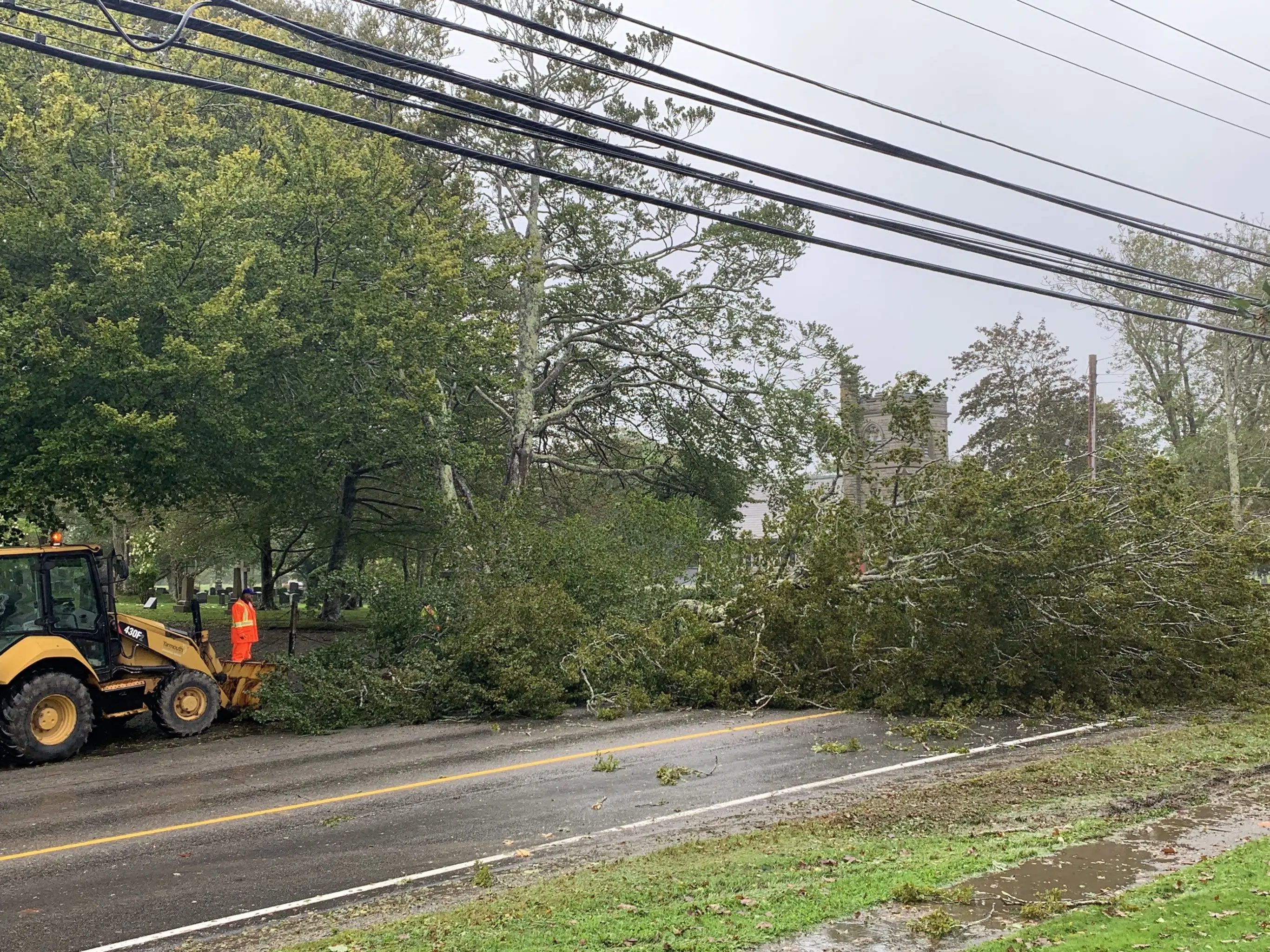Power Update
As of 6:00 p.m. Nova Scotia Power is reporting 146,000 custumers are without power. Although that leaves many in the dark it also marks the first time since early Saturday morning that outage numbers have decreased, having peaked around 160,000 at 5:00 p.m.,.
Nova Scotia Power opened their emergency operations centre at 12:00 p.m. yesterday. Senior director of energy delivery, Matt Drover says the centre will remain open throughout the weekend until all outages have been restored, which may take a while.
“The winds are still very high pretty much everywhere in the province, and we do expect those winds to continue all day today into tonight. So, we won’t really know what the full extent of the storm damage is until tomorrow morning,” said Drover.
When winds gust over 80 kilometres per hour it becomes unsafe for crews to get their buckets in the air and make repairs. Across the province, winds have been reported gusting over 100 kilometres per hour.
To access the Nova Scotia Power Outage map click here.
While tropical storm force winds continue to batter Nova Scotia, we want to remind customers that if you come across a downed wire, please stay as far away as possible. Treat the line as energized and report it to our outage line at 1-877-428-6004. Stay safe and visit… pic.twitter.com/yBngIcirtU
— Nova Scotia Power (@nspowerinc) September 16, 2023
Lee is hovering off the coast of Nova Scotia right now, about 90 Kilometres from Yarmouth where it is expected to make landfall shortly. It is currently classified as a powerful a post-tropical storm. According to Environment Canada, it will continue to batter much of the Maritimes today with heavy rain, strong winds, and high waves along the Atlantic coast.
As of 12:23 p.m., environment Canada recorded wind gust reaching 120 kilometres per hour due to the storm.
Lee is approaching the coast near Yarmouth, on its way to southern New Brunswick and then the Gulf of St. Lawrence on Sunday. Impacts include severe winds, torrential rain and dangerous surf. It will be essential to monitor the forecast for your locality: https://t.co/puPy1K6wdo pic.twitter.com/RdXy7OUaq9
— ECCC Canadian Hurricane Centre (@ECCC_CHC) September 16, 2023
Dangerous Roads
Officials throughout Nova Scotia are asking people to stay off the roads. Trees and power lines are down from Yarmouth to Guysborough creating hazardous driving conditions.
The RCMP are strongly urging people not to travel to coastline as the storm stir up the waters around the province.

Yarmouth Mayor Pam Mood echoed the statement from other officials as the town prepares to take on the brunt of the storm when Lee makes landfall this afternoon
Yarmouth Mayor @PamMood on #HurricaneLee arriving in the area. #NSStorm pic.twitter.com/AaMbtjw4dR
— Kevin Northup (@KevinNorthup) September 16, 2023
Travel Update
The Halifax Regional Municipality has created an interactive map that shows damage and flooding caused by Lee throughout the area. Click here to check it out.
The Confederation Bridge is open, but they have placed the following warning on their website:
“The site-specific weather forecast received from RWDI (Rowan Williams Davies and Irwin) Weather Services today, indicates wind conditions on September 16, 2023 that may result in restrictions of traffic on the Confederation Bridge commencing approximately 15:00hrs, September 16, 2023 until approximately 06:00hrs, September 17, 2023.”
Ferry services across the Maritimes are shut down as the storm intensifies. All Northumberland ferries have halted their trips today, along with the Dartmouth ferry in Halifax.
The Halifax Stanfield Airport has canceled all arriving and departing flights today. At 9:30 a.m. a weather tower at the airport recorded a wind gust of 17 kilometres per hour, that’s just two kilometres per hour shy of a hurricane force wind. To check the status of flights in and out of Stanfield Airport click this link.
For updates on Halifax Transit disruptions please click here.
No flights are scheduled to arrive or depart today (Sept. 16) due to #NSStorm.
— Halifax Stanfield (@HfxStanfield) September 16, 2023
Please contact your airline directly regarding any rescheduled flights resulting from storm cancellations and delays. Stay safe, everyone. pic.twitter.com/n0vsuX9Jlw

Big waves and storm surges
Lee has been churning up the waters across Nova Scotia coastlines all morning. Environment Canada says that 20 foot tall breaking waves are possible in some parts of the province.
Peggy’s Cove announced they are closed to the public today, in an effort to keep people away from the coast.
The Nova Scotia emergency management office is urging people to stay inside during the storm. As tempting as it is to go look at the waves, powerful storm surges could cause onlookers to be swept out to sea.
At this time District 1 reports Peggys Cove Rd is impassible, not certain but I believe this is in the 10000 block, it is washed out with high voltage power lines down. He's unable to leave the area so requesting D2 take the Lucasville call. #HFXTraffic
— Halifax Fire News (@HRMFireNews) September 16, 2023
Support for people living rough
With almost 200 people living rough in Halifax, the municipality has set up shelters throughout the HRM and are conducting checks on local encampments to help out those who may need it.
Here is a list of temporary shelters that will be open during the storm:
- Captain Spry Community Centre (16 Sussex Street, Halifax)
- St. Matthew’s Church (1479 Barrington Street, Halifax)
- Beacon House (125 Metropolitan Avenue, Lower Sackville)
At the request of @hfxgov #EmergencyManagement, team members are continuing to do checks and transport our neighbours living rough as needed. If you know of someone who needs assistance due to this #NSStorm, please contact @211NS and they will connect with our members. pic.twitter.com/CWxevpAFZi
— Halifax SAR (@HalifaxSAR) September 16, 2023
Hurricane History
Nova Scotia, situated on Canada’s eastern coast, has a history of being affected by hurricanes and tropical storms. One of the most devastating hurricanes in its history was Hurricane Juan in 2003. This Category 2 hurricane struck on September 29, causing extensive damage. It brought heavy rain, strong winds, and a powerful storm surge. The storm resulted in six fatalities and caused widespread destruction, with estimated damages exceeding $100 million. Thousands of homes and businesses were damaged or destroyed, and the province’s power infrastructure was severely affected, leaving many without electricity for an extended period.
Hurricane Dorian hit in late August of 2019, although it did not make landfall directly in Nova Scotia, it still had a profound impact. As a Category 2 hurricane, Dorian unleashed powerful winds and torrential rains, leading to massive power outages and significant property damage across the province. It disrupted daily life and triggered a massive cleanup effort.
While these were among the most destructive storms, Nova Scotia has a long history of experiencing hurricanes and tropical storms, with lesser but still notable events like Hurricane Earl in 2010 and Hurricane Bill in 2009.
Overall, hurricanes and tropical storms pose a recurring threat to Nova Scotia, emphasizing the need for preparedness, effective evacuation plans, and resilient infrastructure to minimize the impact of future storms on the province.
The record for rainfall for Yarmouth for September 16th was set in 1940 when a Hurricane dropped over 100mm of rain.
With files from Kevin Northup, Kelli Rickard, Caitlin Snow, Joe Thomson, Evan Taylor, Steve MacArthur, and Scott Pettigrew.









